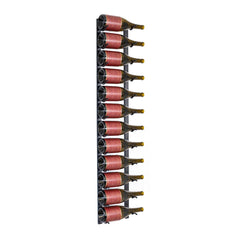Winemakers take great care to bottle their creations and store them for future consumption. Sometimes things can influence the wine's development and create unpleasant aromas and flavors that weren't intended.
We don't want to see our cellared wines go bad, but it happens. Sometimes we drink wines with minor faults and don't even notice. There are cases where flaws in wine can improve the experience, depending on the person.
How exactly does wine go bad?
How can you tell?
What are the most common types of wine faults?
How can Wine go Bad?
Winemakers pay great attention to bottling and storing wine for future use. Things sometimes can interfere with the wine's growth, resulting in undesired aromas and flavors they did not anticipate.
Temperature fluctuations where your wine is being stored, direct sunlight with bottles, and the cork drying out (wine bottles on their sides) are all factors that will affect the quality of the wine. While these factors are within our control – how to properly store wine at home – other factors are not.
Accidents during the grape growing, harvest, winemaking, bottling, and bottle development can all mark the wine's quality.
How does that nursery rhyme go? "Eyes, ears, mouth, and nose?" Forget about the ears, and we'll get down to the bottom of this!
How do we tell if the wine has gone bad?
Key Clues
Eyes – faded, dull or discolored, cloudy, brownish color showing, cork is brittle and breaking
Nose – vinegar, rotten eggs, mold, wet cardboard, wet dog, dull or old, nail polish, sour
Mouth – usually follows what you get on the nose; tasting is a good way to confirm what you sense on the nose
Common Wine Faults
Oxidization
It occurs when the wine has been exposed to too much oxygen and is one of the most common wine faults you'll come across. Your wine will change to a cloudy brownish-orange color and have aromas of sharp vinegar.
If the wine was oxidized when you bought it, take it back! If the wine has oxidized over time due to improper storage at home, learn to store wine properly!
TCA – Cork Taint
Cork Taint typically begins to alter the wine in the production stage, you guessed it, from issues related to the cork. However, TCA can be found in oak barrels as well. TCA gives the wine wet cardboard, wet dog, and moldy type scents. Next to oxidization, TCA is a prevalent wine fault.
If your wine shows signs of TCA, it will have to be taken back!
Reductive – Sulfur
Sulfur is added during the production stage to stabilize wines in the bottle. The smell of smoke and burning matches if often associated and can sometimes be unpleasant. In extreme cases where sulfur has flawed the wine, the smell of rotten eggs, rubber, and skunk can be present.
You can use a decanter to reduce the aromas in the wine. However, if the aromas persist, you may have to take the bottle back.
“Cooked” Heat Damage
Temperature fluctuations can cause corks to expand and contract, allowing oxygen to contact the wine in ways we don't want. With enough heat in these temperature fluctuations, not only will we see oxidization effects, but the wine will also become "cooked" and "jammy". This is why it's essential never to leave your wines in a hot car.
Once a wine is cooked, there is no going back. Better take it back to the store and learn how to control the climate where you store your wine!
UV Light Damage
Wine bottles that come in direct sunlight can result in bad wine! Sunlight carries heat, which we know can lead to issues with oxidization and heat damage, but the UV rays from sunlight can also affect the quality of a wine in other ways.
More commonly in white wines, direct sunlight can make a wine smell like wet wool. Red wine is stored in bottles with a different kind of glass, offering more protection from sunlight.
Microbial & Bacterial Taint
During alcoholic fermentation in the winemaking process, microbial colonies interact with the wine. Usually, these bacteria add complexity to the wine, but sometimes they can become too bold and result in a flaw. Microbes and bacteria can show themselves in different ways – mousy, rope, and hay bail are all descriptions of the resulting scent.
Secondary Fermentation
Secondary Fermentation is a common process of sparkling wines made in the traditional style. This becomes an issue when this secondary process happens in non-sparkling wines. Residual sugars continue to ferment when the wine hasn't been adequately stabilized with sulfur.
Wines can have a spritzy and bubbly mouthfeel with a slight yeast taste. No, thank you!
Don’t Be Fooled! Some wine's aroma and flavors can seem like a fault, but you would be wrong.
Volatile Acidity
VA can be a fault in wine but can also give wine complexity. If you open a wine and the smell of vinegar or balsamic is slightly off-putting, consider decanting the wine to improve the aroma.
Tartrate Crystals
It is most often referred to as sediment. Older wine bottles that have been cellared can have this sediment, but it isn't bad! Feel free to filter out the crystals as you decant the wine. But rest assured, your wine has not gone bad.
Brettanomyces
Brettanomyces is a type of wild yeast that can give off some pretty "wild" flavors. This yeast can help create complexity in wine, but it produces an offensive aroma more often than not.
Wines that smell overly of barnyard, hay bale, saddles, and band-aids can result from this yeast.


